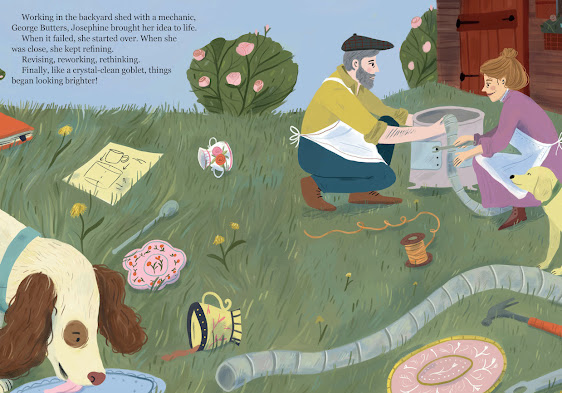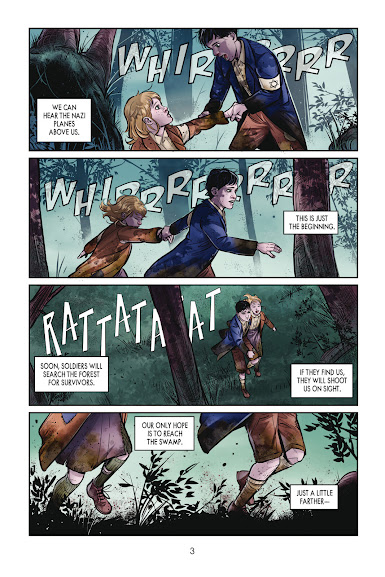It's time for another double review and giveaway courtesy of Sleeping Bear Press!
This is a delightful debut picture book by Kirsten Pendreigh and illustrated by Carmen Mok about a girl who feels left out because no pets are allowed in her apartment.
Her friends make suggestions but none of them felt right. Until one day Luna finds something very unusual.
She names her plant, reads to it, and even takes it for walks--which usually works out well.
Her pet was perfect, even if her friends disagreed.
But, one day, strange clumps of bumps appeared. Luna worried.
During the night, the bumps burst open! A powerful perfume woke Luna...Stephanie's sweet scent wafted through the building.
Luna was thrilled. And when the pet parade walked down her street, Luna was proud to display Stephanie.
Stephanie offered one more surprise. She grew a pod!
I love the sweet ending that shows seeds floating away on the night wind with Luna saying. "Someone out there is waiting to love their own Stephanie."
The back matter includes why houseplants make great pets, recommendations for which houseplants to try, and information about Stephanotis Floribunda.
Kristin Wauson wrote and illustrated this clever and funny debut book. Make sure you read her author interview below to see how she came up with her ideas.
In the beginning, the reader finds Mr. Thatcher building the perfect house. (Aha! The character and his goal in one simple sentence!)
But no matter how hard he tried, something always seemed missing. So, he kept on working and the house grew and grew--but it still wasn't perfect. (Aha #2! We get the character's internal drive and obstacles!)
One morning, his work was interrupted by one of his neighbors.
Of course, Mr. Thatcher doesn't want her to stay in his imperfect house, but the witch makes herself at home baking goodies.
There's another knock on the door.
Mr. Thatcher is suddenly surrounded by the sound of music provided by the three pigs.
Who should also need a house? None other than,
Mr. Thatcher went back to work, but there were MANY interruptions. And the next time he heard knocking, he panicked.
Mr. Thatcher had enough. He moved out.
But then he stopped and looked inside his house and saw that cakes were baking and a stew was bubbling. There was music and laughter and the comforting crackle of logs in the fireplace. For the first time, his house felt like home.
AUTHOR INTERVIEW WITH KRISTEN WAUSON
CAROL: I would like to know how you came up with this fun idea! I love how you integrated the fairy tale characters into the story. Can you tell my readers a little bit about how you developed that idea? What was your inspiration?
KRISTEN: In 2018 I wrote down the idea that became Mr. Thatcher’s House. I was participating in Tara Lazar’s Storystorm, which is something I always like to do. My husband and my father-in-law build Craftsman-style homes and I was inspired by my father-in-law, who has been remodeling his own house, in his spare time, for the past 30 years. It’s going to be perfect one day—if he can ever finish.
I started thinking about all the classic stories I remembered from childhood and realized that many of those stories involved a house problem. In the most obvious one, a trio of pigs had their houses reduced to rubble by a pesky wolf. But, I started having a lot of fun thinking of all the reasons different fairytale characters might need new homes. The bears had suffered a home invasion by Goldilocks, and Hansel and Gretel keep eating a poor elderly woman’s house.
And what did all these characters need? They needed a master carpenter – someone to build them the perfect house!
CAROL: Is this your debut book as an author-illustrator?
KRISTEN: Yes. This is my first published book!
CAROL: Can you tell us about your path to publication?
KRISTEN: I always liked to draw, and I worked as a graphic designer before coming to children’s books. I left my job in 2015 after my youngest son was born. In 2016, I joined SCBWI and attended my first conference. I knew very little about children’s books, so was extremely lucky to be awarded a mentorship with a published illustrator at that conference.
In 2018 I put together the dummy for Mr. Thatcher’s House, which helped me connect with my agent, Adria Goetz during a #PBPitch event. After I signed with her, we polished the dummy and she sent it out for submission in late 2019. Then 2020 happened and everything slowed down considerably, but we accepted an offer in February of 2021, the book was announced in May and it came out in the fall of 2022.
GIVEAWAY
Please leave me your name and email address (if you are new to my blog) and which book you'd prefer to win--I try to honor requests. This giveaway ends on April 21. American addresses only. Subscribe to my blog and/or share this on social media and I'll enter your name twice.





























_cover.jpg)





